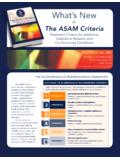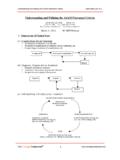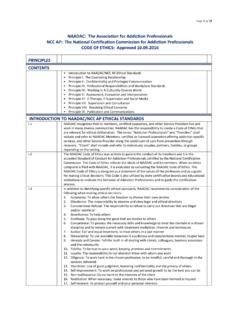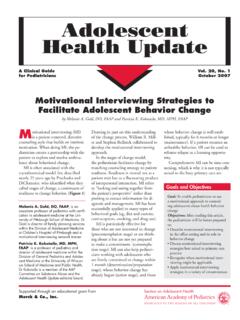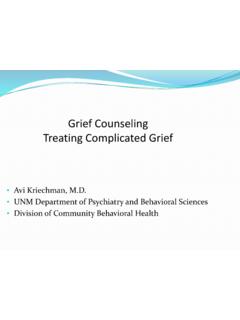Transcription of Group Treatment for Substance Abuse: Addressing Motivation ...
1 Group Treatment for Substance Abuse: Addressing Motivation and Processes of Change Carlo C. DiClemente, ABPPU niversity of Maryland Baltimore Dr. DiClemente has royalty arrangements with the Prevention Research Institute s Solutions Program He is a co-author on the Group Therapy Manual with royalty arrangements from Guilford Press He is on an advisory board member for WestbridgeDual Diagnosis ProgramGroup Therapy? What are they doing?The Treatment Dilemma Most treatments have been developed focusing on the individual and techniques to help this individual to change Most providers deliver the bulk of Treatment in a Group format Group Therapy is not a Treatment .
2 Usually just denotes number of people in the room not what specific type of Treatment is being done Differences and SimilaritiesIndividual Treatment Individual Tailored focus Lots of talk time Difficult to come and not participate Easier to explore historical issues Lack of peer modeling Single support personGroup Treatment Multiple individuals Communality focus Limited talk time Can avoid active participation Group leader has multiple histories in room More modeling possible More support potentialChange: The goal of both Individual and Group Treatment Essentially the goals of Group and individual Treatment are the same Both are trying to motivate and activate change of Substance use or other problematic behavior Groups often have specific change targets.
3 Domestic violence, posttraumatic stress, mindfulness stress reduction, relapse prevention Individual Treatment may have a broader range of targets How combine Group and individual approachesMechanisms of Change Where should we focus when we are trying to get individuals to change whether in individual or Group Treatment ? Most of the research has focused on Types of Treatment (CBT, ACT, DBT, REBT) Therapist characteristics (empathy) Therapeutic Relationship (Alliance, Bond, Tasks, Goal) Most of the active mechanisms are related to the individuals Process of Change ( Motivation , intentions, commitment language, self-efficacy)How Does Treatment WorkClient TherapistAdherence TreatmentEnvironment RecoveryRelationshipEmpathyWorking AllianceActive IngredientsRelapse PreventionFocus on What provider doesWhat about looking at it another way?
4 Focus on What Client DoesEnvironment/Biology Client Process Motivation Efficacy Self Regulation Pressures from policy, others teachable momentsTreatment Client Processes Motivation Engagement Self-Regulation Self-Efficacy Support Systems Multiple problemsSupport Client Processes Efficacy Support systems Multiple Problems Self-RegulationRecoveryTreatment: A Mediator or Moderator of Client ProcessesSTAGES OF CHANGEP recontemplation -Contemplation -Preparation -Action -Maintenance -TerminationPROCESSES OF CHANGEE xperiential Processes Behavioral ProcessesConsciousness RaisingSelf-ReevaluationDramatic ReliefEnvironmental ReevaluationSocial LiberationSelf-LiberationCounterconditio ningStimulus ControlReinforcement ManagementHelping RelationshipsDECISIONAL BALANCESELF-EFFICACYT ranstheoretical ModelHow Do People Change?
5 People change voluntarily only when They become interested andconcernedabout the need for change They become convincedthe change is in their best interest or will benefit them more than cost them They organize a plan of actionthat they are committedto implementing Theytake the actionsnecessary to make the change and sustain the changeStages of Change: Client TasksDiClemente, 2003; 2005 STAGESCLIENT TASKSP recontemplation Not interested in changeFigure out level of interest and concernContemplation Thinking about changePros/cons of change and decision makingPreparation Preparing for changeCommitment and creating an effective/acceptable planAction Initial changeImplementation of plan and revise as neededMaintenance Long-term changeIntegratingchange into lifestyleTheoretical and Practical Considerations Related to Movement Through the Stages of ChangeMotivationPrecontemplation Contemplation Preparation Action
6 MaintenancePersonalConcernsWhat would help or hinder completion of the tasks of each of the stages and sustain or deplete the self-control strength needed to engage in the processes of change needed to complete the tasks? Decision Making Self-efficacyRelapseEnvironmentalPressur eDecisional BalanceCognitiveExperiential ProcessesBehavioral ProcessesRecyclingTASK COMPLETION AND MOVEMENT BETWEEN STAGESPCCONPREPACTMAININTERESTCONCERNRIS K/REWARDDECISIONCOMMMITMENTPLANNINGPRIOR ITIZINGIMPLEMENTTHE PLANREVISELIFESTYLEINTEGRATIONAVOIDRELAP SEM embers in Different StagesPrecontemplationActionContemplatio nWhy are the Stages of Change Important?
7 If you can identify what stage the person is in and understand their You will know critical tasks needed to move ahead You can develop strategies to be most effective in helping them to move forward in their change processWhere Do We Come In?STAGESPROVIDER TASKSP recontemplation Not interested in changeRaise doubt aboutcontinuing problematic behavior; Increase client s awareness of risks and problemsContemplation Thinking about changeEncourage client to voice reasons for change & risks of not changing; help tip the balance of pros and cons Preparation Preparing for changeHelp develop a personalized change planAction Initial changeHelp the client develop relapse prevention strategies; Adjust change plan as neededMaintenance Long-term changeHelp client identify strengths for long-term change.
8 Provide support DiClemente, 2003; 2005 Processes of ChangeExperiential ProcessesConsciousness-RaisingSelf-Reeva luationDramatic ReliefEnvironmental ReevaluationSocial LiberationBehavioral ProcessesSelf LiberationStimulus ControlCounter ConditioningReinforcement ManagementHelping RelationshipsClient Processes of Change Change engines that enable movement through the stages of change Doing the right thing at the right time Cognitive/Experiential processes during early stages Behavioral processes in preparation, action and maintenance During recover action stage focus on behavioral processesMechanisms of ChangePrecontemplationContemplationPrepa rationActionMaintenanceSeek InformationChoose for Self to ChangeCreate a Personalized PlanRemember, change happens bit by bit.
9 To Promote it you need to getClients to engage in these activities at different points in the Impact of Behavior on SelfAssess Impact of Behavior on Environment & OthersEmotional Reaction to Consequences of BehaviorConsider Society s Perception of BehaviorReward Positive BehaviorIdentify People to Support ChangeSubstitute Behavior for More Positive OnesIdentify Triggers for Problem BehaviorProvider Strategies What do you do to engage each of these processes? What do you do with less motivated patients that would activate some of these experiential processes? What do you do with you action oriented patients that activate the behavioral processes?
10 How can we do this in Group ?One AttemptMy colleagues (Velasquez, Crouch and Stephens) developed an empirically sound Group Treatment approach, based on skills and strategies that could be mastered by clinicians who believe in clients inherent ability to change, and tailored to meet clients where they are in their stages of changeDelivered in a client-centered, goal-directed style, utilizing activities and strategies to elicit the specific change processes that promote successful behavior change. Using MI spirit and strategies to complement the TTM model and as a way of facilitating change, even with clients who are resistant or not yet ready to change.

